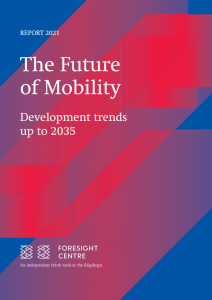The Future of Mobility

The purpose of the Future of Mobility research is to identify the key factors that steer mobility and the choice of transport, to describe these from the point of view of Estonia’s development goals, and to link these to the mobility profiles of the Estonian residents and to the crucial transport investments.
Mobility and opportunities to move are closely linked to how we live our lives. People move around for work, studies, recreation, etc. Mobility in general is linked to various fields – such as environmental policy, health care, energy policy, regional policy, and education policy. Social changes over the last two decades have considerably influenced how and why we move and use the transport system. Over the next decades, we are more than likely to observe even bigger changes.
The main challenges of the next decades are linked to limited natural resources, increasing pressure on ecosystems, and intensification of the consequences of climate change, i.e. in brief – with the environment. In addition, urbanisation continues on an increasing scale, as do the related challenges. Adding this to the intensifying pace of technological changes, incl. digitalisation and automation, we can outline the general action framework within which we will probably need to shape transport and mobility. These trends indicate that one of the main challenges for mobility is to enhance sustainability and ecological considerations. Here, we might see the faster-and-further mindset giving way to mindfulness in the 21st century, with the accessibility of services and the living environment rising to the forefront.
The human-oriented approach is gaining a lot more importance in planning and managing mobility. Understanding how people and businesses make mobility-related decisions and introduce new technologies allows us to plan and assess the impact of different changes, and apply technological innovations for the benefit of individuals and society.
So far, Estonia’s major challenges have included the increasing dependence on cars, the reduced independent mobility of schoolchildren and the elderly, and the adverse health effects of transport. Today, Estonia is yet to embark on a transition towards sustainable mobility; however, the mobility development documents include an increasing number of principles of sustainable mobility. The choices on the future of the field must be based on knowledge and analyses because only this would allow achieving the strategic global and local goals, and make the soundest decisions, incl. long-term infrastructure investments. The research supports the drafting of the transport and mobility development plan in the Ministry of Economic Affairs and Communications, and will hopefully contribute towards more reliable choices and a better mobility environment.
The mobility research will result in a study of the mobility profiles of Estonian residents and an analysis of the trends, strategic choices, and development outlooks that affect mobility.
Key research questions
- What are the key factors and possible dramatic changes that affect people’s mobility and means of transport?
- What are the development perspectives of domestic mobility in Estonia?
- What are the main dilemmas around mobility that the decision-makers should keep in mind?
Reports linked to the research
News linked to the research
-
29.04 2022The sustainability of Estonia’s transport system mostly depends on Harju County
The sustainability of Estonia’s transport system mostly depends on Tallinn and Harju County, which contribute nearly 50% of the total mileage of all the vehicles in Estonia, says the report of the Foresight Centre “The Future of Mobility. Development trends up to 2035“, which is now published in English.

 An independent think tank at the Riigikogu
An independent think tank at the Riigikogu 


